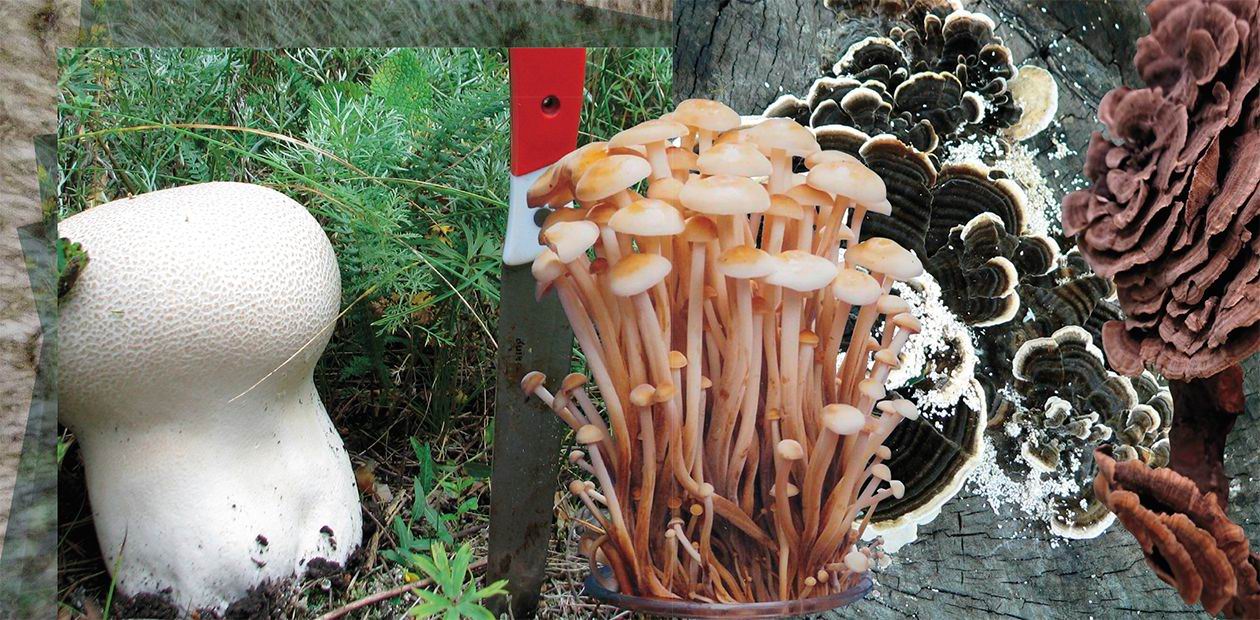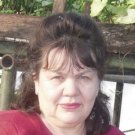Fungal Pharma: fungi against viruses and tumors
Many peoples of the world have used fungi for thousands of years. The uses are far beyond food: fungi are used in religious ceremonies and to treat diseases. The oldest known sculptures depicting mushrooms, discovered in Central America, date back to over 3000 years ago. Judging by an embroidered motif on a carpet from a Hunn burial mound Noin-Ula (I century B.C – early I century A.D.), Soma – the legendary drink of immortality, prepared in sacred rituals of Northwest India, was in fact made from the Psilocybe mushrooms, which contain psychedelic substances (Polosmak, 2010). Traditional medicine has many examples of the use of higher fungi to fight diseases and extend youth. The torch has been picked up by the modern pharmacological industry, which produces anti-tumor, antiviral and immune-boosting drugs based on substances derived from higher fungi. Mycologists from Vector together with their colleagues from the Central Siberian Botanical Garden have been researching the therapeutic activity of wild Siberian mushrooms for many years. They have succeeded in isolating over 130 strains of higher fungi, many of which have shown high pharmacological activity
The class of higher Basidiomycetes, which includes most mushrooms and wood-decaying fungi, contains over 15 thousand known species. Of those, over a hundred have been used in the traditional medicine of China, Korea, Japan and other countries of Southeast Asia.
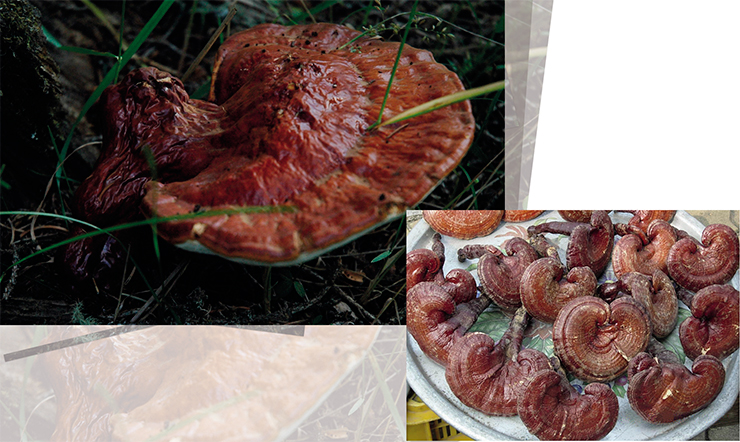
Experts in ancient Chinese medicine believe that the healing properties of reishi, or lingzhi — “the immortality fungus” (Ganoderma lucidum) by far exceed those of any herb. In Eastern medicine, this fungus is considered to be a panacea, used to treat a number of acute and chronic conditions, from neurasthenia and cardiac failure to cancer and joint inflammation as a powerful sedative, tonic, anti-inflammatory and laxative medicine as well as an antidote to various poisonings. To extend their youth, the Chinese emperors took another famous wood-decaying fungus — the shiitake. It was the first mushroom to be cultivated both for culinary use and for medical applications such as treatment of stomach pains and headaches, colds, liver diseases, measles in children, etc.
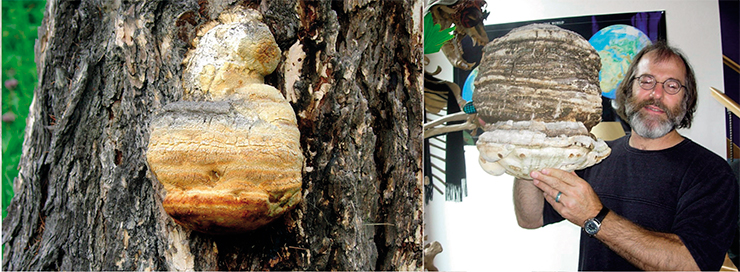
In Europe, medicinal properties of fungi were generally disregarded; however, Dioscorides, a Roman scientist, described the use of the larch polypore to treat gastrointestinal problems — almost 2000 years ago.
The larch polypore, which is parasitic on conifers, was especially popular in Russia; it was used as a styptic (blood-stopping medication) and to treat tuberculosis. It used to be an important export to Europe: in 1879, almost 8 metric tons of dried fruitbodies were exported!
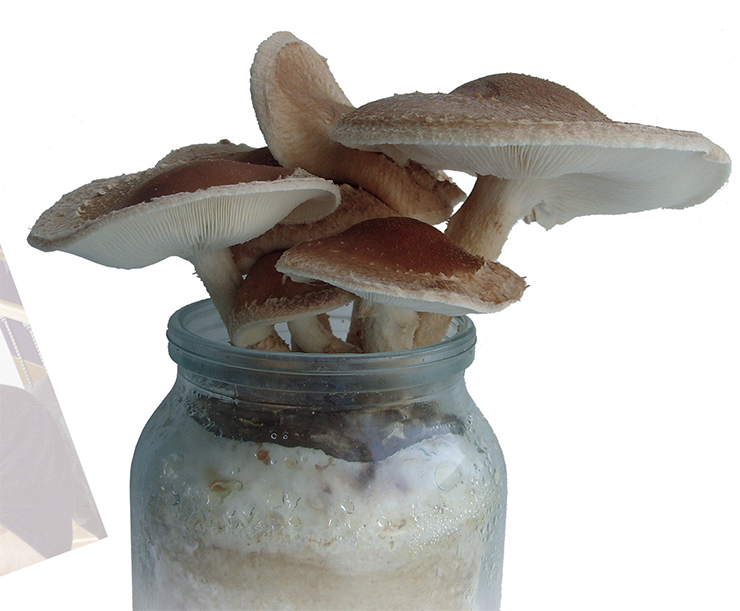
Puffballs were also well-known medicinal fungi; they are sometimes called “Band-Aid mushrooms” for their styptic and bactericidal properties. According to written documents from the XVI — XVII centuries, chaga was a popular medicinal fungus in Russia. Its use in the Russian folk medicine is documented in medical and herbalist books of the XIX century (Denisova, 1998). Chaga was used for gastrointestinal isssues (ulcers, gastritis, polyps), tuberculosis, diseases of the liver and heart, and, remarkably, for malignant tumors of the lips, skin, lungs, stomach, and rectum.
Nowadays, preparations from basidiomycete fruitbodies are winning the pharmaceutical markets of Europe and the United States; in Japan, which has suffered a nuclear disaster, such drugs make up up to 30 percent of its immense market of oncostatic and immunocorrector drugs. Research laboratories across the world are involved in active investigation of biologically active fungal compounds.
Safe «chemotherapy»
Japanese scientists were among the first to publish research on medicinal compounds from mushrooms, largely as an aftermath of the nuclear explosions in Hiroshima and Nagasaki. These papers reported the studies of anti-tumor activities of water extracts of wood-decaying fungi (reishi, shiitake, chaga, etc.) that were carried out on laboratory animals inoculated with human tumors, such as Sarcoma‑180 (Ikekawa et al., 1968; 1969).
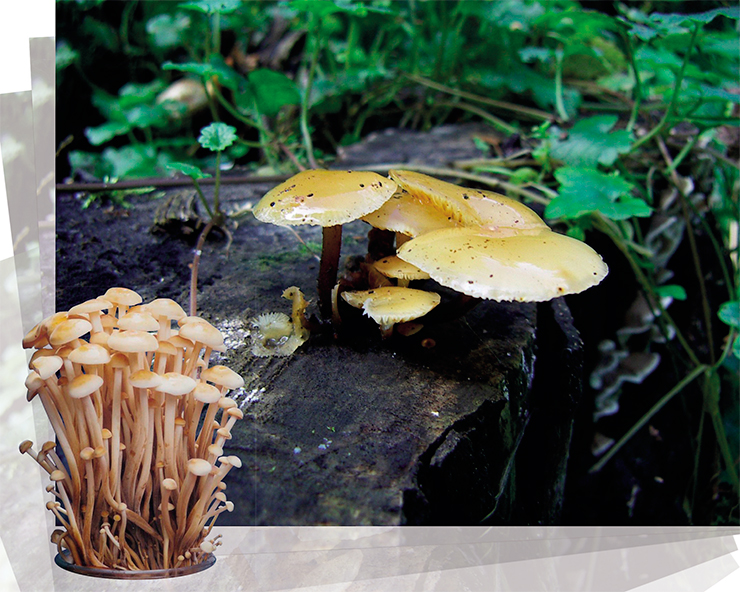
It turned out that their anti-cancer properties were from glycans — a type of polysaccharides, which are high molecular weight carbohydrate compounds made up of monosaccharides linked with glycosides. Glycans extracted from natural materials are a mixture of molecules differing by the degree of polymerization. Many of these molecules have been named a long time ago, including cellulose, starch, chitin, etc. Sometimes, polysaccahrides are named after their source raw material, from which they were initially extracted. This is how the first fungal anti-tumor polysaccharides got their names, including lentinan, extracted from fruitbodies of the shiitake, Lentinus edodes (currently Lentinula edodes), and schizophyllan, extracted from the culture liquid of the split-gill mushroom, Schizophyllum commune (Wasser, 2002).
Biologically active substances can be extracted not only from fungal fruitbodies but also from the mycelium during cultivation, or even from the culture liquid. In this sense, fungi are an inexhaustible source of polysaccharides with anti-tumor and immune boosting properties.
One should keep in mind that different strains of the same species may produce polysaccharides with different properties. For instance, the proteoglycan crestin was firs isolated in Japan from the CM‑101 strain of the turkey tail fungus Trametes versicolor, and polysaccharidepeptide (PSP) — in China based on the Cov‑1 strain of the same species. Both compounds have the same polysaccharide component linked to different protein molecules.
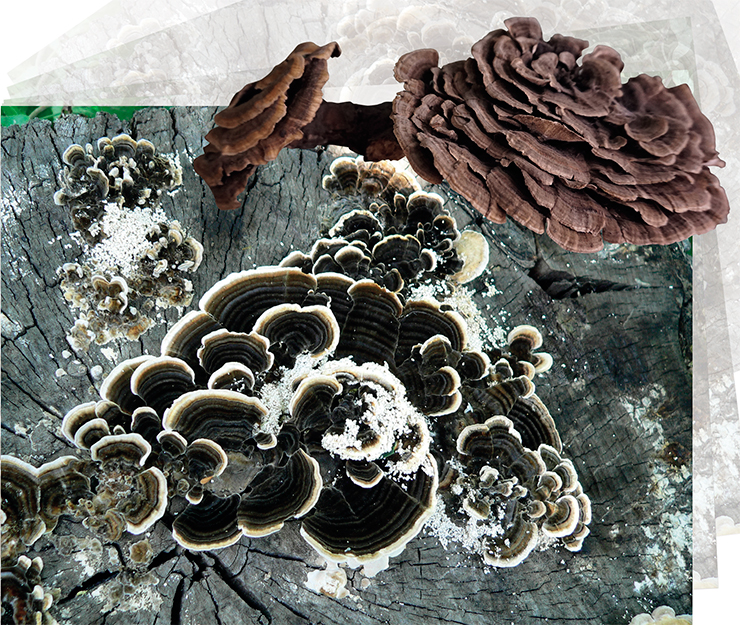
Fungi have been found to contain other carbohydrate-protein compounds with anti-cancer properties, such as glycoproteins, in which the carbohydrate component is characterized by irregular structure. The velvet shank mushroom produces anti-carcinogenic glycoproteins EA6 and proflavin (Wasser, 1999). The provinces of Japan where this mushroom has been traditionally cultivated and consumed as food, risk of cancer has been found to be lower than the country’s average (Ikekawa, 2005).
We are still far from fully understanding the fine interactions of these fungal carbohydrate-protein polymers with receptors of cells of the immune system. Apparently, they act as primary inductors of chemical and immunological mechanisms of the body, raising the activity of leukocytes and stimulating the production cfo IL‑1 and IL‑6 cytokines as well as macrophages, T-lymphocytes and other elements of the human and animal immune system.
Unlike conventional chemotherapy, fungal drugs are nontoxic and can be safely combined with other types of oncological treatment, including radiotherapy. This is why they are now viewed as a new type of anti-tumor compounds.
An ode to chaga
One of the best-known medicinal fungi in Russia is Inonotus obliquus — its sterile, or asexual phase that forms black, irregular masses on living trunks of birch (or rarely, other trees) is what we call chaga (чага).
People of Russia have long used chaga to prevent and treat many illnesses, including oncological diseases. In the mid‑20th century, scientists took active interest in the fungus. Research has shown that chaga extracts actually increase the defensive response of the body, activate metabolism in brain tissue, exhibit anti-inflammatory properties both with external and internal use. Moreover, they have been shown to be capable of inhibiting the growth or even completely eliminating certain tumorous formations (Martynova, 1959; Yakimov, 1959; Shivrina, 1966).
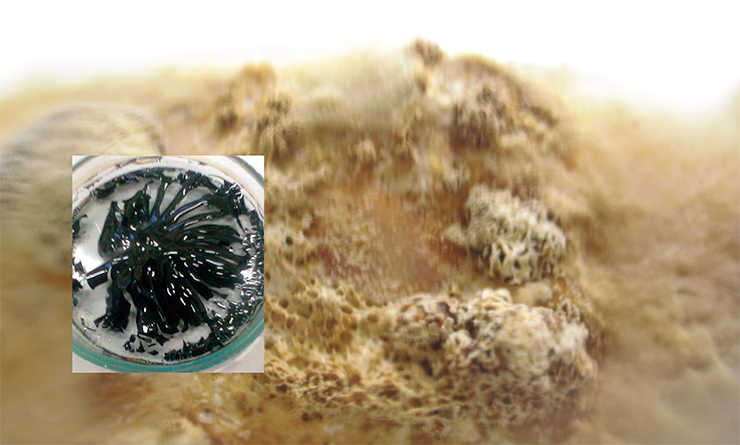
Natural compounds of chaga that are formed during the close interaction of the fungus and the tree are characterized by a very wide range of properties. Scientists agree in that the main biologically active compounds of chaga are water soluble, intensively colored chromogenic complexes, which form from chemically active phenol aldehydes, polyphenols, oxyphenol-carbonic acids and their quinones (Kuznetsova, 1959; Yakimov, 1959; Shivrina, 1966).
As the result of these studies, chaga and chaga-based medications were included in the State Drug Registry back in 1959, and can be bought in any pharmacy. New medications based on chaga keep appearing. For instance, the N. Blokhin Russian Center for Oncology developed Chagovit and Chagolux, used for treatment of oncological diseases and type 2 diabetes (Shashkina et al., 2008).
Pharmacies sell a number of chaga preparations, including befungin, which contains 33% В of chaga extract and cobalt salts. According to the literature, prolonged consumption of cobalt salts can cause intoxication and necrotizing cardiomyopathy. Research in Vector using laboratory mice confirmed that befungin causes massive areas of dystrophic cardiomyocytes –cells of the heart muscle. This can pose a serious danger for long-term users of befungin, such as HIV or cancer patientsAnti-tumor properties of chaga are gaining recognition abroad. For instance, Chinese researchers extracted four compounds from chaga, which suppress growth of tumor cells. One of them, inotidiol, has been experimentally shown to help counter resistance to traditional chemotherapy gained by colonies of cancer cells (Jiang et al., 2007). Scientists are researching other promising compounds extracted from chaga, such as pterins — nitrous heterocyclical organic compounds (Zhang et al., 2011; Fan et al., 2012).
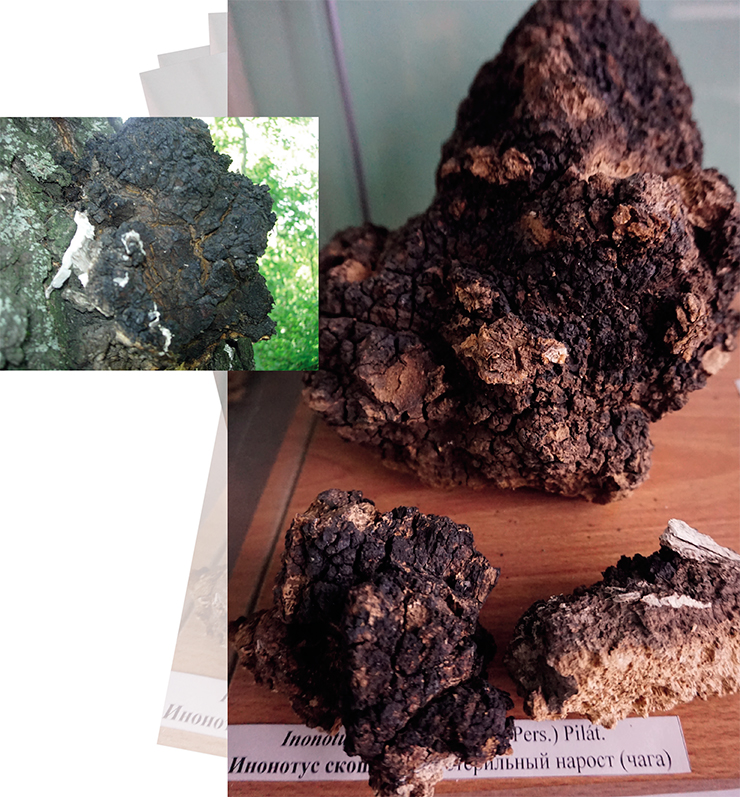
Unfortunately, the supply of wild chaga in Russia is being severely depleted. Chaga on living trees takes 10 to 12 years to form, and numerous commercial organizations harvest chaga extensively, both supplying pharmacies nationwide and exporting raw chaga.
Nowadays, chaga is harvested further and further from populated areas, but even in the vastness of Siberia, its supply is not unlimited. Moreover, fungi cannot be harvested in areas subjected to industrial or radioactive pollution as they are capable of accumulating various elements (Khimich, Isaeva, 2011; Popova, 2011; Sibirkina, 2012). Is there a solution?
Do not wait for mercy from Mother Nature
Nowadays, many fungi are cultivated on different substrates for their fruitbodies. This includes both edible species (white button agarics, oyster mushrooms, shiitake, etc.) and purely medicinal species, such as the reishi, chicken of the woods, etc.). Unlike fungi collected in the wild, cultivated fungi grow in controlled environments with specific substrates, humidity, and aeration modes, which differ for different species. In Russia, the most widely cultivated mushrooms are the white button agaric and oyster mushroom. In other countries, cultivated species are way more diverse.
However, biotechnology is steadily gaining more ground in medical mycology: instead of fruitbodies, mycelial biomass is grown. To achieve this, the method of deep cultivation is used, when fungi are grown on media formulated individually for each species and strain. Large volumes of fungal biomass can be grown in sterile vessels called fermenters. Research has demonstrated the high potential of this method, because the deep mycelium, similarly to fruitbodies, accumulates important biologically active substances in comparable concentrations; concentrations of proteins, lipids and carotenoids in deep mycelium exceed those of fruitbodies (Babitskaya et al., 2006).
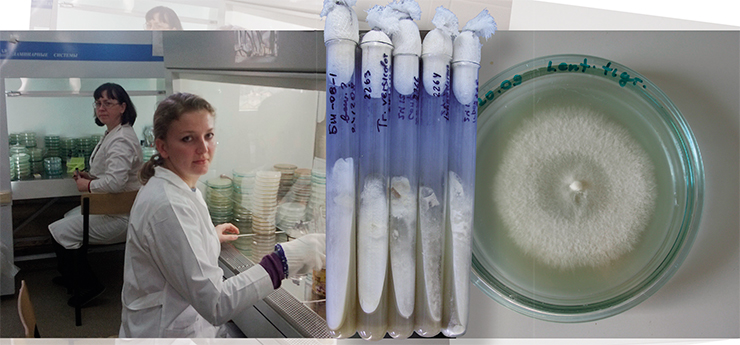
Regardless of how fungi are grown, be it on substrates or in fermenters, it is crucial to have pure cultures of biomass-producing strains. This has been a subject of intensive research since 1980. Currently, two methods of fungal strain isolation are used: from fruitbody tissues and from spores. In our experience, the first method is preferable because together with spores, the substrate can be contaminated with microscopic mites that feed on mycelium and can pose a threat to the whole collection.
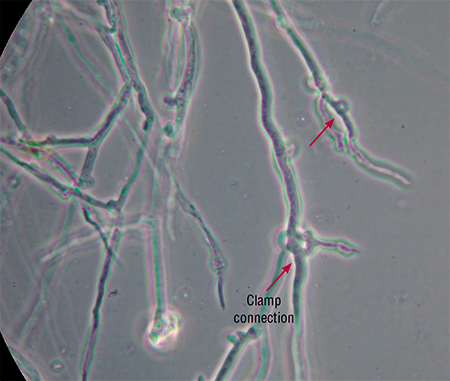 Growing fungal cultures is not easy. Fungi grow very poorly on most growth media; in other cases, there are contamination issues. Another problem specific to fungi stems from the existence of large numbers of mycophilous fungi from other systematic groups, which normally live on basidiomycete fruitbodies. There have been cases when these fungi were mistakenly isolated and grown instead of the basidiomycetes of interest.
Growing fungal cultures is not easy. Fungi grow very poorly on most growth media; in other cases, there are contamination issues. Another problem specific to fungi stems from the existence of large numbers of mycophilous fungi from other systematic groups, which normally live on basidiomycete fruitbodies. There have been cases when these fungi were mistakenly isolated and grown instead of the basidiomycetes of interest.
For this reason, isolation, identification and maintenance of cultures must be performed by professional mycologists.
Fungal cultures are identified using morphological, physiological and biochemical methods as well as with electron microscopy. Many higher basidiomycetes are characterized by the presence of the so-called clamps, or clamp-connections — small, arch-shaped cells on their mycelial strands. This feature is stable for a species or sometimes even for a whole genus. However, the most reliable method to assert the “authenticity” of an isolated culture is obtaining fruitbodies from that mycelium.
All roads lead to Vector
Shortly after the discovery of anti-tumor activity of water extracts, polysaccharides and other compounds derived from higher mushrooms, a number of studies were published dealing with the antiviral activity of the same preparations (Tochikura, 1988; Collins, 1997; Wasser, Weis, 1999). For instance, it turned out that lentinan, a well-known polysaccharide from the shiitake mushroom, initially discovered to have anti-tumor properties, has shown antiviral activity against a number of viruses, including tick-borne encephalitis, type H flu, and even HIV (Tochikura, 1988).
When we began isolating cultures of higher fungi at Vector, we proceeded from two assumptions. First, forest ecosystems of West Siberia are rich in medicinal mushrooms, as evidenced by publications of our colleagues — mycologists from the Central Siberian Botanical Garden (Perova, Gorbunova, 2001). Our acquaintance eventually developed into fruitful partnership (Gorbunova et al., 2005).
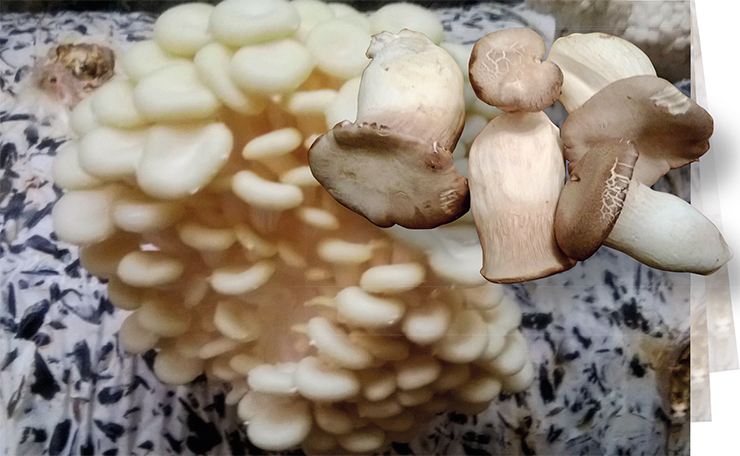
Second, Vector is a unique organization with its impressive collection of human viral pathogens and facilities and equipment necessary to work with these dangerous agents. This gave us a chance to pursue our goal and evaluate the antiviral activity of different fungal metabolites. For this reason, when selecting fungal species for isolation into culture, we preferred species known for their anti-tumor properties.
As the result, in 2008 we started a collection of isolated cultures of higher fungi of Siberia, which currently contains 132 strains of 60 species. The majority of these species have a long history of use in folk medicine, and some are also good edibles, albeit not widely known to the general public. The latter include different species of oyster mushrooms (Pleurotus spp.), the shaggy mane (Coprinus comatus), chicken of the woods (Laetiporus sulfureus), velvet shank (Flammulina velutipes), etc. Inedible medicinal mushrooms include different polypores, or conks, such as the larch polypore (Laricifomes officinalis), artist’s conk (Ganoderma applanatum agg.) and turkey tail fungus (Trametes versicolor) (Teplyakova, Kosogova, 2014).
Fungal Pharmacology
At Vector, we evaluated the antiviral activity in human and animal cell cultures of over five hundred samples of Siberian fungi, using water extracts and individual compounds (polysaccharides, melanins, and proteins) produced from these fungi. As the result, we selected the most promising natural strains that showed antiviral activity against HIV‑1 virus, herpes simplex 2 virus, East Nile fever virus, various subtypes of influenza and orthopoxviruses (viruses of smallpox, variolovaccine and monkeypox).
The broadest spectrum of antiviral activity was exhibited by samples from chaga — they suppressed all of the studied viruses. Such properties of chaga can be attributed to its complex chemical composition, dominated by a chromogen-polypheno-oxycarbonic complex, which is similar to humic acids by its physico-chemical characteristics. The dark color of chaga extracts is due to high molecular weight pigments called melanins, which are known for their antioxidant properties. Other substances discovered in chaga include terpenoids, sterols, and a sesquiterpene (Shivrina, 1966; Ryzhova et al., 1997; Kukulyanskaya et al., 2002; Shashkina et al., 2006).
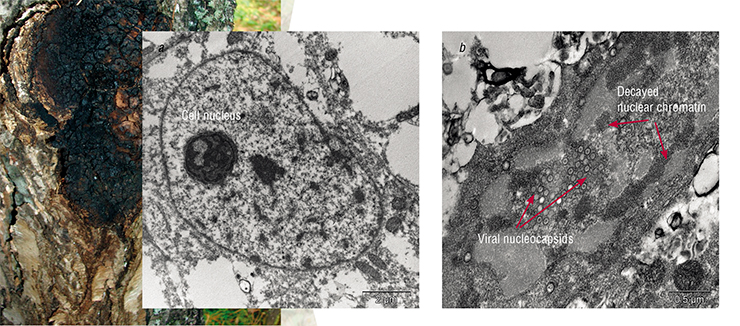
The four strains of chaga in the collection of Vector differ by their properties and biomass productivity. Adjusting growth media and cultivation conditions for the strain F‑1244 allowed optimizing the biomass output, yielding up to 22.3 g/l by dry mass if grown in a fermenter. Based on this strain, we developed a regimen of producing melanin with a broad range of antiviral activity (Teplyakova, Kosogova, 2015; Ananko et al., 2015).
FUNGI AGAINST HIV Numerous publications worldwide indicate that fungal compounds can inhibit the human immunodeficiency virus (HIV). For instance, crestin and PSP – preparation of the turkey tail fungus Trametes versicolor, a glycoprotein from the oyster mushroom Pleurotus ostreatus, and the proteins velutin and flammulin from the velvet shank Flammulina velutipes can inhibit viral replication in cell culture. Immune Assist 24/7, a drug made from extracts and polysaccharides from several fungal species, proved to be efficient in trials in HIV-infected patients, which is evidence that these compounds derived from fungi have potential for the treatment this infection (Adotey, 2011).Research carried out in Vector has demonstrated that both fruitbodies and mycelium of West Siberian basidiomycetes contain biologically active substances that inhibit HIV‑1 reproduction. For instance, natural chaga extracts added to the MT‑4 cell culture before and after virus adsorbtion completely suppressed its reproduction in cells at concentrations of 0.03 µg/ml by dry mass (Teplyakova et al., 2008). Melanin, both from naturally occurring chaga and from culture liquid and biomass of the F‑1244 strain, also demonstrated high antiviral activity (Ananko et al., 2015).
Other notable compounds include polysaccharides and complexes they form with proteins (glycoproteins). Research has shown that antiretroviral activity of water extracts of different species of oyster mushrooms, which are widely cultivated, is directly connected with the levels of these compounds in these fungi (Gashnikova et al., 2011; Kosogova, 2013). Protein fractions obtained from the biomass of the thin-walled maze polypore (Daedaleopsis confragosa) strain #2266 deep culture (Gileva et al., 2014).
Remarkably, all of the studied preparations of Siberian fungi that demonstrated antiviral activity against HIV‑1 were also effective against the Herpes simplex type 2 virus. The HIV virus is often associated with the genital herpes virus, and in these cases, the acquired immunodeficiency syndrome is usually considerably more severe
Other basidiomycetes that have shown potential for the development of antiviral drugs include the turkey tail polypore, two species of oyster mushrooms (Pleurotus ostreatus and P. pulmonarius), thin-walled maze polypore (Daedaleopsis confragosa), artist’s conk (Ganoderma applanatum agg.) and common stinkhorn (Phallus impudicus). All of them inhibited three or four of the studied viruses, including HIV‑1
Some experts believe that such antiviral action of compounds derived from fungi is connected with their nonspecific reaction to free viral particles. In other words, these substances interact with cell membranes, competing with virions for receptors or polysaccharides on their surface, which they use to attach to and enter the host cell. Preliminary treatment of cells with “fungal” substances blocks these cell receptors, preventing infection. Treatment of the cell culture after it has been infected prevents the viral progeny from leaving the infected cells, stopping the development of the infection (Razumov, 2013).
Fungi against cancer
Fungi can play an important role in the prevention of malignant processes initiated in the human body by viruses. Over 20 percent of all tumors in humans have viral origins. Scientists have long ago established the etiological role of the human papillomavirus in the development of cervical cancer, and of the hepatitis B virus — in the development of liver cancer (Gurtsevish, 2008). Viral respiratory diseases also pose a threat in this sense, including the flu virus, which can set off oncological processes, as confirmed by experiments performed by the Flu Scientific Research Institute in St. Petersburg (Smirnova et al., 2011).
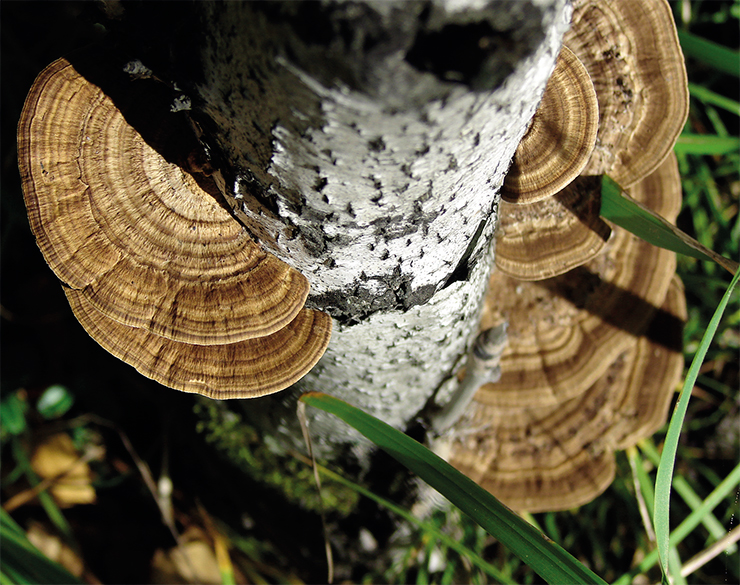
In these experiments, scientists infected eight human cell lines with different doses of the type A flu virus. Large doses of the virus caused apoptosis (programmed cell death). However, with small doses, two cell lines (of endothelium, lining the internal surface of blood vessels, and of glioblastoma, a type of brain cancer) a latent viral infection persisted for three reinoculation cycles, as evidenced by the presence of viral RNA and nucleoproteid. This process was accompanied by proliferation (extensive growth) of the cell culture, which could only be suppressed with antivirals such as remantadin. The authors of this study discuss the issue of the possible connection between flu infection and consequent development of cardiovascular and neurological issues, however, these data can also be interpreted as pointing at a certain role of viruses in the development of tumors.
Analysis of specimens of fruitbodies and mycelia of Siberian basidiomycetes (aqueous extracts, polysaccharides, glycoproteins, melanins) performed at Vector point at a correlation between antiviral and anti-tumor activity of the same species of fungi (Teplyakova, Kosogova, 2014). This is proof of the existence of universal mechanisms of action in biologically active compounds derived from fungi on pathological human cells and viruses; it also facilitates the discovery of new compounds that possess both antiviral and anti-tumor properties.
Regarding possible applications, extracts from medicinal fungi and the fungi themselves can be used for efficient prophylaxis of viral diseases, especially in spring and fall, and some forms of cancers caused by viruses.
In recent decades, researchers were able to test and document many old bits of knowledge about medicinal mushrooms. Discovery of new species and stains and isolating them into cultures for biomedical purposes becomes a priority task.
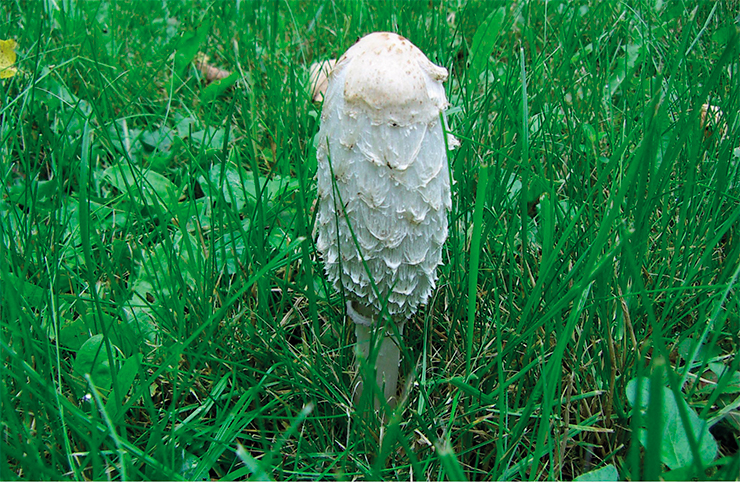
The collection of strains of basidiomycetes from various natural habitats in West Siberia hosted at Vector plays an important scientific and applied role in the development of medical and preventative preparations. This task is also important in the light of the International Convention on Biodiversity Conservation; data obtained by Novosibirsk scientists point at a possibility of developing efficient antiviral and anti-tumor drugs based on mycelial biomass. Biologically active compounds of the fungal biomass, such as melanin, polysaccharides, proteins, etc., are classified as low toxicity substances, which makes this direction of research extremely promising
Further research must aim at the evaluation of the efficiency of fungal preparations in prevention and treatment of specific diseases, including clinical trials. The public must be informed about the benefits and healing potential of mushrooms, as most people are unaware of these properties. Nowadays, as many new viral diseases emerge and the numbers of people with HIV and cancer are on the rise, using such fungi as chaga, reishi, shiitake, oyster mushroom and others as preventative health foods and drinks can mitigate the negative impact of chemotherapy and enhance the natural defenses of the body, protecting it from a number of diseases.
Литература
Ананько Г. Г. Теплякова Т. В. и др. Меланины из глубинной культуры Inonotus obliquus и их противовирусная активность в отношении вируса простого герпеса 2 типа // Успехи медицинской микологии. Т. 14. 2015. С. 384-388.
Бабицкая В. Г., Щерба В. В., Гвоздкова Т. С. Новые биологически активные добавки на основе глубинного мицелия базидиальных грибов // Успехи медицинской микологии. 2006. Т. 7. С. 178—180.
Вассер С. П. Наука о лекарственных шляпочных грибах: современные перспективы, достижения, доказательства и вызовы // Биосфера. 2015. Т. 7. № 2. С. 238—248.
Денисова Н. П. Лечебные свойства грибов. Этномикологический очерк. СПб.: Изд-во СПбГМУ, 1998. 59 с.
Перова Н. В., Горбунова И. А. Макромицеты юга Западной Сибири. Новосибирск: Изд-во СО РАН, 2001. 158 с.
Теплякова Т. В., Косогова Т. А. Высшие грибы Западной Сибири – перспективные объекты для биотехнологии лекарственных препаратов. Новосибирск, 2014. 298 с.
Wasser S. P. Medicinal mushrooms as a source of antitumor and immunomodulating polysaccharides // Appl Microbiol Biotech. 2002. V. 60. P. 258—274.
Teplyakova T., Kosogova T. Fungal Bioactive Compounds with Antiviral Effect // Journal of Pharmacy and Pharmacology. 2015. V. 3. N. 8. Р. 357—371.
В публикации использованы фото автора


